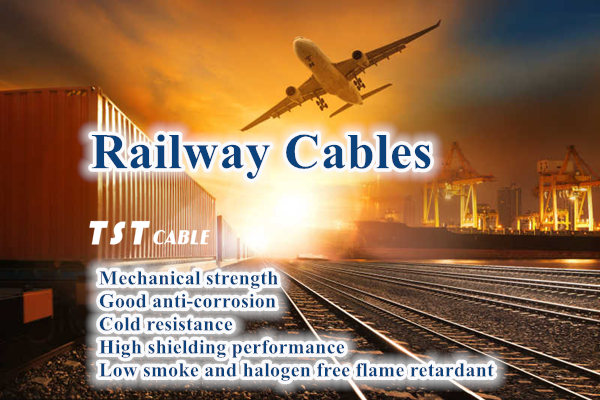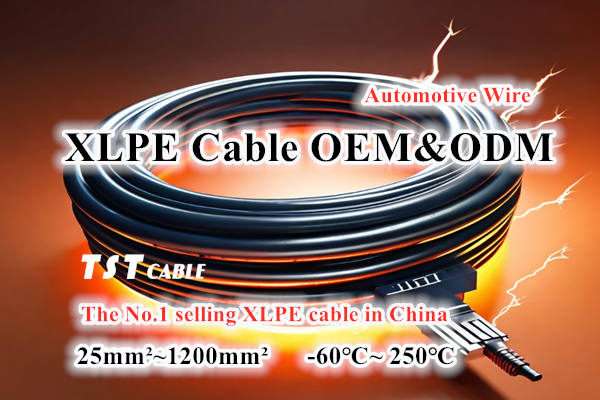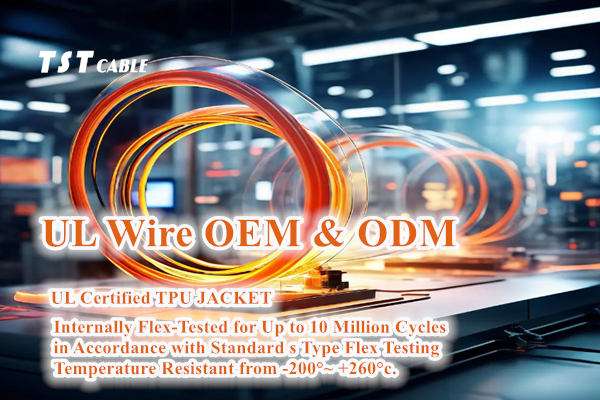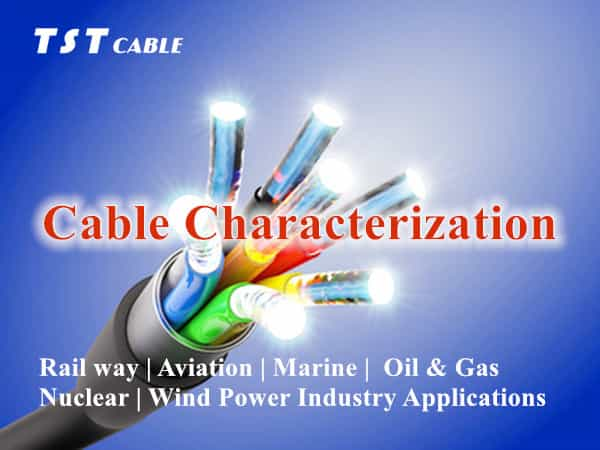Introduction to Cross-linked Polyethylene Insulated Cables

Cross-linked polyethylene insulated cable (XLPE cable) is a widely used type of cable that is particularly suitable for low- and medium-voltage power transmission systems. xlpe, as an advanced insulating material, offers a number of advantages over traditional polyvinyl chloride (PVC) and ethylene propylene rubber (EPR) insulating materials. XLPE, as an advanced insulation material, offers a number of advantages over traditional PVC and EPR insulations. TST CABLES will introduce the characteristics, manufacturing process, application areas and advantages of cross-linked polyethylene insulated cables.
Cross-linked polyethylene insulated cable is the use of chemical or physical methods, so that the cable insulation polyethylene molecules from the linear molecular structure into the main body of the reticular molecular structure, that is, thermoplastic polyethylene into thermosetting crosslinked polyethylene, which greatly improves its heat resistance and mechanical properties, reduces its shrinkage, so that it is no longer melted after the heat and maintains the excellent electrical properties.
Cross-linked polyethylene insulated cables are suitable for fixed laying in distribution networks or industrial installations with rated voltage of 0.6/1kV and below.
Structure of cross-linked polyethylene insulated cable
Cross-linked polyethylene insulated cable is mainly composed of conductor, insulation layer, metal shield, sheath and accessories.
- Conductor: The conductor is the main part of the cable for transmitting electric energy, and there are two main materials: copper conductor and aluminum conductor. Copper conductor conductivity, oxidation resistance, corrosion resistance, but expensive; aluminum conductor is cheap, but low conductivity, the need to increase the cross-sectional area of the conductor in order to meet the power transmission requirements.
- Insulation: insulation is a key part of the cable transmission of electrical energy, effectively preventing current leakage and discharge between the charged body, reduce current loss, improve cable transmission efficiency. The thickness of cross-linked polyethylene insulation layer is generally 0.8mm-1.2mm, using electron beam or radiation cross-linking technology, so that its intermolecular cross-linking, improve insulation performance.
- Metal shielding layer: metal shielding layer is for the cable to provide protection against lightning strikes and reduce electromagnetic field interference. Common metal shielding materials are copper tape screen knock and aluminum foil shielding, screen knock effect is remarkable.
- Sheath: Sheath is the external protective layer of the cable, to protect the cable from mechanical damage, chemical corrosion and environmental impact. Common sheath materials are PVC, PE, HDPE, LSZH and so on.
- Accessories: Accessories include cable head, cable connector, cable bracket, etc., which are indispensable accessories in the process of cable installation and use.
Characteristics of cross-linked polyethylene insulated cable
- Industrial frequency rated voltage: U0/U (Um) 0.6/1 (1.2) kV.
- Allowable long-term maximum working temperature of cable conductor is 90℃.
- When short-circuited (maximum duration of not more than 5s) the maximum permissible temperature of the cable conductor does not exceed 250 ℃.
- Cable laying ambient temperature should not be less than 0 ℃.
- The bending radius of the cable is not less than 15 times the outer diameter of the cable.
Features of cross-linked polyethylene insulated cable
High temperature resistance: The maximum continuous working temperature of XLPE insulation can reach 125°C or even higher, while PVC cables are generally 70°C, which means that XLPE cables can be operated at higher temperatures, allowing for a greater amount of flow-carrying capacity.
Chemical stability: XLPE has excellent chemical resistance and is not easily eroded by acids, alkalis and solvents, improving the service life of the cable.
Mechanical strength: XLPE has high mechanical strength and can withstand large external impact and stretching, reducing the risk of damage to the cable during installation and use.
Electrical performance: XLPE has a low dielectric constant, low dielectric loss and uniform electric field distribution, which improves the electrical performance and stability of the cable.
Non-toxicity: Compared with PVC cables, XLPE cables do not release toxic gases during combustion, making them more environmentally friendly and safer.
Thermal stability: XLPE has good thermal stability and can maintain its electrical and mechanical properties even at high temperatures.
Non-melting: XLPE does not melt at high temperatures, helping to prevent further damage to the cable in the event of an overload or short circuit.
Shear resistance: Cross-linked polyethylene insulated cables have high shear resistance and can maintain their original structure and performance even when torn or squeezed by external forces.
Aging resistance: Cross-linked polyethylene insulated cables have excellent aging resistance and can withstand long-term use and extreme environments.
XLPE cables have become an indispensable part of modern power transmission systems due to their excellent heat resistance, chemical stability, mechanical strength and electrical properties, especially in application scenarios that require higher cable performance. With the continuous progress of technology, the manufacturing process and performance of XLPE cables will be further improved, so that they can play a greater role in the future power transmission field.
Manufacturing process of cross-linked polyethylene insulated cables
XLPE insulation is a process of transforming the linear polyethylene molecular structure into a three-dimensional mesh structure, known as cross-linking, by chemical or physical means. This process improves the heat resistance and mechanical properties of the polyethylene.
The manufacturing process mainly includes:
Polymer blending: the polyethylene resin is mixed with cross-linking agents and other additives.
Extrusion: The blended material is extruded through an extruder to form the insulation layer of the cable.
Cross-linking treatment: Cross-linking is carried out either chemically (e.g. using silane) or physically (e.g. by electron beam radiation) to form a three-dimensional network structure.
Cooling and testing: The cables are cooled and then tested for electrical and physical properties to ensure that standards are met.
Application areas of cross-linked polyethylene insulated cables
Cross-linked polyethylene insulated cables are widely used in the fields of power generation, power transmission, power distribution and telecommunication, etc. The cables are used in petroleum, chemical industry, metallurgy, aerospace industry, railroad, shipbuilding, urban construction and many other industries. Can be used for high temperature, high pressure, high speed, heavy load and other complex conditions of power transmission.
- Power generation: In power generation systems such as thermal power generation, cogeneration and nuclear power plants, cables have to withstand high temperature, radiation and complex electromagnetic environments, cross-linked polyethylene insulated power cables can provide excellent electrical, mechanical and chemical properties to ensure stable and reliable power transmission.
- Power transmission: cross-linked polyethylene insulated power cables can be used for transmission of high-voltage lines, which can effectively reduce power loss and electromagnetic field interference.
- Power Distribution: Used in distribution networks of 0.6/1kV and below. In power distribution systems such as urban and industrial areas, cross-linked polyethylene insulated power cables can be used for transmission and distribution of medium and low voltage lines, with stable and reliable performance and long service life.
- Telecommunication: Cross-linked polyethylene insulated power cables are also used for signal transmission in telecommunication system, with good anti-interference performance and signal transmission effect.
- Industrial installations: suitable for fixed laying in factories, mines and other industrial environments.
- Buildings: In the electrical wiring of buildings, XLPE cables are very popular due to their good electrical and mechanical properties.
- Special environments: such as submarine cables, high-temperature environments, chemical industrial areas, etc., XLPE cables are chosen for their excellent chemical resistance and thermal stability.
Commonly used models and names of XLPE cables
YJV copper core cross-linked polyethylene insulated PVC sheathed power cable
YJLV Aluminum Core Cross-linked Polyethylene Insulated PVC Sheathed Power Cable
YJY copper core cross-linked polyethylene insulated polyethylene sheathed power cable
YJLY aluminum core cross-linked polyethylene insulated polyethylene sheathed power cable
YJV22 copper core cross-linked polyethylene insulated steel tape armored PVC sheathed power cable
YJLV22 Aluminum core cross-linked polyethylene insulated steel tape armored PVC sheathed power cable
YJV23 Copper core cross-linked polyethylene insulated steel tape armored polyethylene sheathed power cable
YJLV23 Aluminum core cross-linked polyethylene insulated steel belt armored polyethylene sheathed power cable
YJV32 copper core cross-linked polyethylene insulated steel wire armored PVC sheathed power cable
YJLV32 aluminum core cross-linked polyethylene insulated steel wire armored polyvinyl chloride sheathed power cable
XLPE cable installation precautions:
Temperature control: Installation should ensure that the ambient temperature is not lower than the minimum temperature recommended by the cable manufacturer to avoid damage to the cable insulation.
Bending radius: Follow the minimum bending radius recommended by the manufacturer. Excessive bending may cause damage to the internal structure of the cable and affect electrical performance.
Cable Termination and Joints: Proper cable termination and joint making is critical, improper handling may lead to partial discharges and corona, affecting the long-term reliability of the cable.
Earthing and shielding: Ensure that the cable’s shield and earth conductor are correctly connected to provide good EMC and prevent the risk of electric shock.
Environmental factors: Select the right type of cable and protection measures, taking into account the environmental conditions of the cable’s installation location, such as humidity, chemical corrosion, UV radiation, and so on.
XLPE cable maintenance and inspection:
Periodic Inspection: conduct regular visual inspections of the cable to look for any visible damage or abnormalities such as cracks, abrasion or corrosion.
Electrical Testing: Evaluate the electrical performance of the cables using methods such as insulation resistance tests, voltage withstand tests and partial discharge tests to identify potential problems in a timely manner.
Temperature Monitoring: Monitor the temperature of cables during operation to ensure that the maximum allowable working temperature is not exceeded and to prevent insulation deterioration caused by overheating.
Cleaning and anticorrosion: Regularly clean the environment around the cables to prevent the accumulation of dust and corrosive substances on the cables, and take anticorrosion measures when necessary.
Professional training: Ensure that personnel responsible for cable installation and maintenance are properly trained to understand the characteristics of the cable, installation requirements and maintenance procedures.
Future development trend of cross-linked polyethylene insulated cables
As technology continues to advance, cross-linked polyethylene insulated cables are also evolving, with key trends including:
Environmentally friendly materials: developing more environmentally friendly crosslinking agents and insulation materials to reduce the impact on the environment, in line with the development of green energy.
High-performance materials: researching new XLPE materials with higher temperature and voltage resistance and longer service life to meet more demanding applications.
Intelligent cables: Integrate sensors and communication functions so that cables can monitor their own status and transmit data in real time to improve the intelligence of the power grid.
Resistant to extreme environments: Developing specialty XLPE cables for extreme low temperatures, high temperatures, high pressures, or strong radiation environments to expand their applications.
Cost-effectiveness: Reduce the production cost of XLPE cables by optimizing the manufacturing process and material formulations to improve their market competitiveness.
TST CABLES – A Leading Global Supplier of Cross-linked Polyethylene Insulated Cables
In the silent journey of electricity, TST CABLES cross-linked polyethylene insulated cables, in the name of technology, guards every inch of light transmission. With its excellent heat resistance (125℃), stable electrical properties and tough mechanical strength, it constructs a safe and efficient power transmission network. Whether it is hot and cold, or complex and changing environmental challenges, XLPE cables have always been consistent, to ensure the stable transmission of power.TST CABLES cross-linked polyethylene insulated cables, with its excellent performance, occupies an important position in the field of power transmission in the world, and will continue to meet the higher requirements of the future energy system through technological innovation. If you have needs or questions about XLPE cables, welcome to email us immediately, senior engineers are dedicated to your efficiency, but also get free samples.
Also available in:
English




